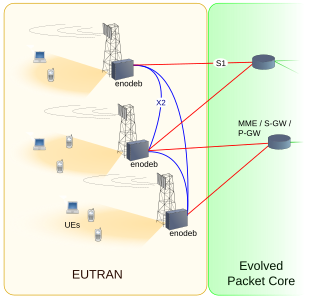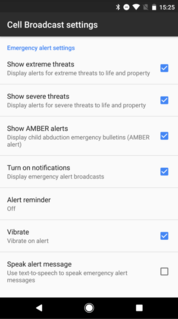
General Packet Radio Service (GPRS) is a packet oriented mobile data standard on the 2G and 3G cellular communication network's global system for mobile communications (GSM). GPRS was established by European Telecommunications Standards Institute (ETSI) in response to the earlier CDPD and i-mode packet-switched cellular technologies. It is now maintained by the 3rd Generation Partnership Project (3GPP).
The Universal Mobile Telecommunications System (UMTS) is a third generation mobile cellular system for networks based on the GSM standard. Developed and maintained by the 3GPP, UMTS is a component of the International Telecommunication Union IMT-2000 standard set and compares with the CDMA2000 standard set for networks based on the competing cdmaOne technology. UMTS uses wideband code-division multiple access (W-CDMA) radio access technology to offer greater spectral efficiency and bandwidth to mobile network operators.
In the Universal Mobile Telecommunications System (UMTS) and 3GPP Long Term Evolution (LTE), user equipment (UE) is any device used directly by an end-user to communicate. It can be a hand-held telephone, a laptop computer equipped with a mobile broadband adapter, or any other device. It connects to the base station Node B/eNodeB as specified in the ETSI 125/136-series and 3GPP 25/36-series of specifications. It roughly corresponds to the mobile station (MS) in GSM systems.
The GPRS core network is the central part of the general packet radio service (GPRS) which allows 2G, 3G and WCDMA mobile networks to transmit IP packets to external networks such as the Internet. The GPRS system is an integrated part of the GSM network switching subsystem.
Mobility management is one of the major functions of a GSM or a UMTS network that allows mobile phones to work. The aim of mobility management is to track where the subscribers are, allowing calls, SMS and other mobile phone services to be delivered to them.
The IP Multimedia Subsystem or IP Multimedia Core Network Subsystem (IMS) is a standardised architectural framework for delivering IP multimedia services. Historically, mobile phones have provided voice call services over a circuit-switched-style network, rather than strictly over an IP packet-switched network. Alternative methods of delivering voice (VoIP) or other multimedia services have become available on smartphones, but they have not become standardized across the industry. IMS is an architectural framework that provides such standardization.
In telecommunications networks, RANAP is a protocol specified by 3GPP in TS 25.413 and used in UMTS for signaling between the Core Network, which can be a MSC or SGSN, and the UTRAN. RANAP is carried over Iu-interface.
The IEEE 802.21 refers to Media Independent Handoff (MIH) and is an IEEE standard published in 2008. The standard supports algorithms enabling seamless handover between wired and wireless networks of the same type as well as handover between different wired and wireless network types also called Media independent handover (MIH) or vertical handover. Vertical handover was first introduced by Mark Stemn and Randy Katz at U C Berkeley. The standard provides information to allow handing over to and from wired 802.3 network to wireless 802.11, 802.15, 802.16, 3GPP and 3GPP2 networks through different handover mechanisms.
An Access Point Name (APN) is the name of a gateway between a GSM, GPRS, 3G and 4G mobile network and another computer network, frequently the public Internet.
GPRS Tunnelling Protocol (GTP) is a group of IP-based communications protocols used to carry general packet radio service (GPRS) within GSM, UMTS, LTE and 5G NR radio networks. In 3GPP architectures, GTP and Proxy Mobile IPv6 based interfaces are specified on various interface points.
The Mobile Application Part (MAP) is an SS7 protocol that provides an application layer for the various nodes in GSM and UMTS mobile core networks and GPRS core networks to communicate with each other in order to provide services to users. The Mobile Application Part is the application-layer protocol used to access the Home Location Register, Visitor Location Register, Mobile Switching Center, Equipment Identity Register, Authentication Centre, Short message service center and Serving GPRS Support Node (SGSN).

E-UTRA is the air interface of 3rd Generation Partnership Project (3GPP) Long Term Evolution (LTE) upgrade path for mobile networks. It is an acronym for Evolved Universal Mobile Telecommunications System (UMTS) Terrestrial Radio Access, also referred to as the 3GPP work item on the Long Term Evolution (LTE) also known as the Evolved Universal Terrestrial Radio Access (E-UTRA) in early drafts of the 3GPP LTE specification. E-UTRAN is the initialism of Evolved UMTS Terrestrial Radio Access Network and is the combination of E-UTRA, user equipment (UE), and E-UTRAN Node B or Evolved Node B (eNodeB).

Cell Broadcast (CB) is a method of sending messages to multiple mobile telephone users in a defined area at the same time. It is defined by the ETSI’s GSM committee and 3GPP and is part of the 2G, 3G, 4G LTE (telecommunication) and 5G standards. It is also known as Short Message Service-Cell Broadcast (SMS-CB) or CB SMS.

In telecommunications, a femtocell is a small, low-power cellular base station, typically designed for use in a home or small business. A broader term which is more widespread in the industry is small cell, with femtocell as a subset. It connects to the service provider's network via broadband ; current designs typically support four to eight simultaneously active mobile phones in a residential setting depending on version number and femtocell hardware, and eight to sixteen mobile phones in enterprise settings. A femtocell allows service providers to extend service coverage indoors or at the cell edge, especially where access would otherwise be limited or unavailable. Although much attention is focused on WCDMA, the concept is applicable to all standards, including GSM, CDMA2000, TD-SCDMA, WiMAX and LTE solutions.
System Architecture Evolution (SAE) is the core network architecture of mobile communications protocol group 3GPP's LTE wireless communication standard.
The access stratum (AS) in computer networking and telecommunications is a functional layer in the UMTS and LTE wireless telecom protocol stacks between radio network and user equipment. While the definition of the access stratum is very different between UMTS and LTE, in both cases the access stratum is responsible for transporting data over the wireless connection and managing radio resources. The radio network is also called access network.
+- - - - - -+ +- - - - - - -+ | HTTP | | Application | +- - - - - -+ +- - - - - - -+ | TCP | | Transport | +- - - - - -+ +- - - - - - -+ | IP | | Internet | +- - - - - -+ +- - - - - - -+ | NAS | | Network | +- - - - - -+ +- - - - - - -+ | AS | | Link | +- - - - - -+ +- - - - - - -+ | Channels | | Physical | +- - - - - -+ +- - - - - - -+
The UMTS channels are communication channels used by third generation (3G) wireless Universal Mobile Telecommunications System (UMTS) networks. UMTS channels can be divided into three levels:
E-UTRAN Node B, also known as Evolved Node B, is the element in E-UTRA of LTE that is the evolution of the element Node B in UTRA of UMTS. It is the hardware that is connected to the mobile phone network that communicates directly wirelessly with mobile handsets (UEs), like a base transceiver station (BTS) in GSM networks.
LTE-WLAN aggregation (LWA) is a technology defined by the 3GPP. In LWA, a mobile handset supporting both LTE and Wi-Fi may be configured by the network to utilize both links simultaneously. It provides an alternative method of using LTE in unlicensed spectrum, which unlike LAA/LTE-U can be deployed without hardware changes to the network infrastructure equipment and mobile devices, while providing similar performance to that of LAA. Unlike other methods of using LTE and WLAN simultaneously, LWA allows using both links for a single traffic flow and is generally more efficient, due to coordination at lower protocol stack layers.
Frequency bands for 5G New Radio, which is the air interface or radio access technology of the 5G mobile networks, are separated into two different frequency ranges. First there is Frequency Range 1 (FR1), which includes sub-6 GHz frequency bands, some of which are traditionally used by previous standards, but has been extended to cover potential new spectrum offerings from 410 MHz to 7125 MHz. The other is Frequency Range 2 (FR2), which includes frequency bands from 24.25 GHz to 52.6 GHz.



